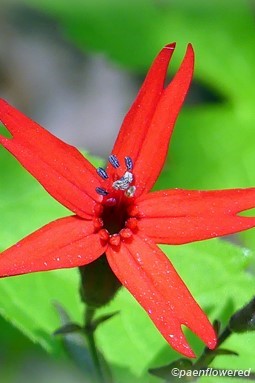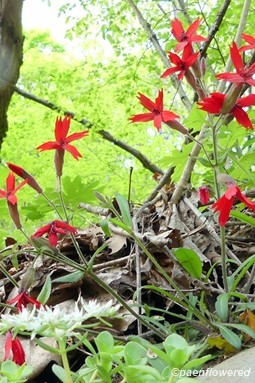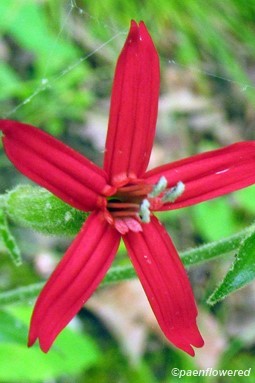Silene virginica
Silene virginica firepink
The bright scarlet flowers of the fire pink are hard to miss against the background of the forest floor. This native wildflower is a short-lived perennial (2-3 years) that has five scarlet red petals that meet in the center to form a tubular calyx. Each narrow petal has a notch or cleft at the tip. The flower is about .75 to 1.5 inches in diameter.
The fire pink plant can grow one to two feet high but may be smaller in restricted environments. The flower stalk is long and slender and sometimes reclines. It begins blooming in April and continues through June. The basal leaves are lance-shaped and about 1 ½ to 4 inches long. The leaves on the stem have a similar shape and can be up to 6 inches long. Most of the plant is covered in tiny sticky hairs.
This species mostly grows in deciduous forests throughout the eastern United States, mostly from Western Pennsylvania southwest to Arkansas. The USDA documents it in all the counties of Western Pennsylvania except for Erie, Crawford and Somerset. It does not seem to grow further east in Pennsylvania. It is not an abundant plant in this general area - I have seen it growing in only a few areas. Fire pink is often found in clearings or on rocky or sandy slopes but can grow in dappled sunlight in forested areas.
The principal pollinator of this flower is the Ruby-throated hummingbird, though some butterflies may also visit the flower. The flower provides nectar as a “reward” for these pollinators. There are several other wild "Pinks" that grow in this area, but this is the one with the deepest red coloration. The catchfly, named for the sticky hairs on its stem that trap or discourage crawling insects, belongs to the same genus. For that reason, the fire pink is sometimes called the scarlet catchfly. Both are members of the family Caryophyllaceae, (also known as the pink or carnation family).
Habitat & Range
Occasional in upland woods, wooded slopes, and stream banks.
Mostly found in the west of the state.
Range: Found from Western Pennsylvania southwest to Arkansas
Wetland code: Not classified
Phenology
Flowers May to early June.
Plant Codes
S-rank: No rank
G-rank: G5 (Secure)









Comments
Have you spotted this plant in your area? We'd love to hear about your experience! Share your comments or questions about the plant below. Comments are moderated before posting.